After a 98-day hiatus, the Palace Museum has finally reopened its doors, albeit with daily guest limits and strict measures to prevent COVID-19, Wang Kaihao reports.
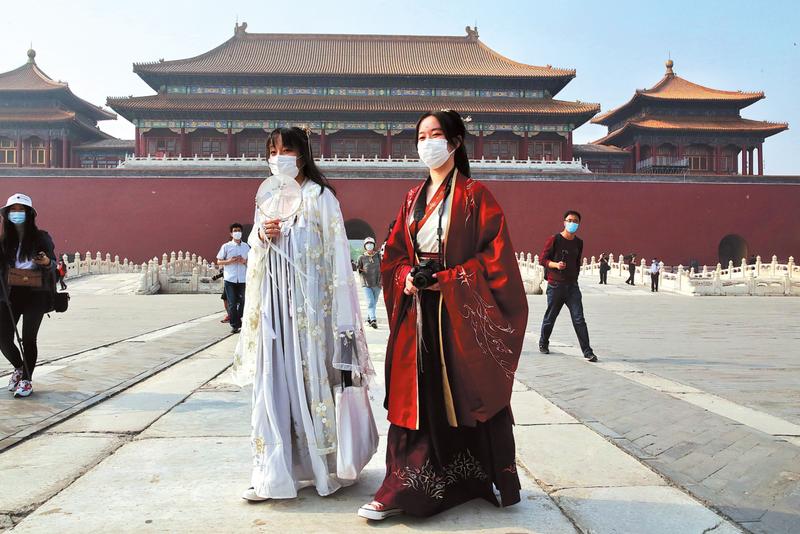 Fan Yuxuan (right) and Hong Qizhuo, two senior high school students, wear hanfu to visit the Palace Museum on May 1. (JIANG DONG / CHINA DAILY)
Fan Yuxuan (right) and Hong Qizhuo, two senior high school students, wear hanfu to visit the Palace Museum on May 1. (JIANG DONG / CHINA DAILY)
Despite not being on the front line of the battle with the novel coronavirus, Zhuang Jingwen, a Beijing-based engineer who is in charge of maintaining medical instruments at a hospital, has been much busier than normal for the past few months.
Because of her tight schedule, Zhuang did not have much time to fully relax and her thirst for culture was never quenched.
On April 29, as she was riding her bike home, a long-awaited message popped up on her cell phone-the Palace Museum, also known as the Forbidden City, would reopen on May 1.
Closed for 98 days as part of containment measures to slow the spread of COVID-19, it has been the heritage site's longest shutdown in decades.
The museum, which acted as China's imperial palace from 1420 to 1911, celebrates its 600th birthday this year.
"Finally, it's back open," she tells China Daily. "I rushed back home to book the ticket. It's so exciting."
In the past few years, Zhuang had visited the Palace Museum at least once a month. Until the outbreak hit, she did her best not to miss any major exhibitions. Her social media accounts are full of pictures taken at the museum.
"After spring came, I would sometimes walk along the moats outside the Forbidden City, staring at the turrets, and imagining what it looked like inside the high walls," Zhuang recalls, baring her poetic soul. "I also could not help climbing up Jingshan hill (to the north of the Forbidden City) to take a look at the palace from high up.
"The flourishing blossoms inside had no chance to be admired by visitors, there is pathos as long as I'm thinking of that."
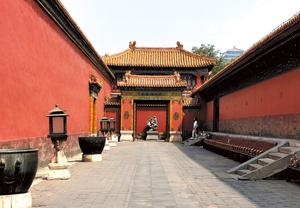 A part of the museum in the western section. (WANG KAIHAO / CHINA DAILY)
A part of the museum in the western section. (WANG KAIHAO / CHINA DAILY)
Eager for access
The UNESCO World Heritage Site and the world's largest surviving complex of palatial architecture covering 720,000 square meters has not been fully accessible following the reopening.
Only some outdoor areas, mainly along the central axis and some gardens and courtyards on both the eastern and western sides are temporarily accessible. All indoor galleries, the city walls, and most souvenir shops, remain closed.
Only 5,000 visitors whose entry tickets have all been booked in advance online will be allowed entry each day-3,000 before 1 pm and a further 2,000 afterward. Of course, QR codes which indicate heath condition, the measurement of body temperature, and 1-meter social distancing are also required.
Zhuang was lucky. The first 5,000 tickets sold out within 90 minutes after the news was released, and all 25,000 tickets throughout the 5-day May Day Holiday were snapped up within 12 hours.
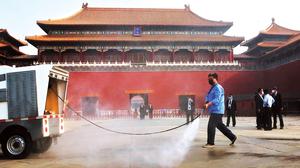 A staff member of the museum sprays disinfectant as one of the measures taken to ensure the safety of visitors. (JIANG DONG / CHINA DAILY)
A staff member of the museum sprays disinfectant as one of the measures taken to ensure the safety of visitors. (JIANG DONG / CHINA DAILY)
On the morning of May 1, Zhuang was one of the earliest in line, waiting in front of the Meridian Gate of the Forbidden City. For her, the special moment felt like a ritual.
After she takes off her white coat and puts on her hanfu-traditional Chinese clothing of the Han people-Zhuang instantly changes from a medical engineer into an enthusiast who worships the brilliance of cultural heritage.
She says it is her regular clothing every time she visits the palace, as it echoes the surroundings.
While she was sad to see the closed doors of the galleries, Zhuang was pragmatic. She originally planned to visit several key temporary exhibitions during the Spring Festival (which fell on Jan 25), but she was unable to due to the closure.
"I worry about missing them," she says, "but, only walking outdoors is still better than not being able to go inside the palace at all."
Perhaps the pandemic has given people a stronger inclination to seek out some familiar beauty, like the Forbidden City.
Despite living in Beijing, senior high school students Fan Yuxuan and Hong Qizhuo have not visited the palace in years.
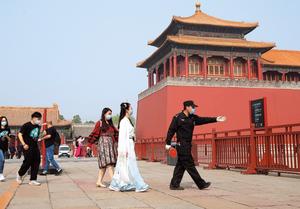 One-meter social distancing is required at the entry of the museum. (ZOU HONG / CHINA DAILY)
One-meter social distancing is required at the entry of the museum. (ZOU HONG / CHINA DAILY)
However, the pair have admired exquisite photos of the Forbidden City posted online, particularly after snowfall.
"We struggle to find the time because of (a tight) school calendar," Fan says. "When we finally decide to make the trip during winter break, the outbreak of COVID-19 halted it."
Hong adds: "Since we've waited for so long, we don't want to wait any longer."
For parents, taking in the nation's history and culture is good for the education of their children.
The morning of May 1 was given a sort of ceremonial aura by Sun Yuanyuan, a teacher who gets up at 3 am with his 11-year-old son. Together with several other children and their mothers, they rode bikes to attend the national flag-raising ceremony on Tiananmen Square at the dawn. Then, they headed to the Palace Museum nearby.
"I visited alone in December," Sun says. "But, at this special time, I feel it is particularly meaningful for children to know more about the country's history. I didn't hesitate for one moment as soon as I saw the news of the reopening.
"There is a privilege to coming here now: There are so few people," Sun smiles.
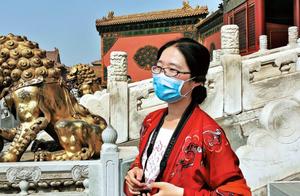 Zhuang Jingwen, a fan of the museum. (WANG KAIHAO / CHINA DAILY)
Zhuang Jingwen, a fan of the museum. (WANG KAIHAO / CHINA DAILY)
Leisurely visit
Last year, over 19 million visitors poured into the Palace Museum. That number would probably have been exceeded this year, especially with the added draw of the venue's 600th anniversary, but COVID-19 pushed the "emergency brake" on the flow of visitors.
The museum has maintained an 80,000-people daily cap since 2015. It has largely eased the problem of overwhelming crowds, which reached a peak of 182,000 people on Oct 2, 2012. However, for most visitors to the museum before the outbreak, it was probably still difficult to find a corner to take a breath amid the constant flow of people.
Experiencing the chaotic situation of being overwhelmed during that record day in 2012, Zhuang says the temporary 5,000-people cap is a rare gift for fans of the Forbidden City.
"I can stroll in the compound and take the time to notice the areas I used to neglect," she explains, enjoying a fresh feeling for the old place, despite being a frequent guest.
Guo Meixia, deputy director of the publicity and education department of the Palace Museum, says that visitors now have the time and space to view details close-up and feel the subtly differing atmospheres of various courtyards, allowing them to better resonate emotionally with historic figures.
"There are too many objects on the routes, which people used to hastily pass with little time for scrutiny," Guo says. "But there are many interesting stories hidden in their patterns and shapes, and slower steps will provide surprises for people."
During the Qingming Festival Holiday in April, Guo's team launched a day-and-a-half livestreaming tour of the closed Palace Museum. Many online viewers were amazed by the close-up details in the architecture and on artifacts in "familiar" spaces of the empty compound.
It was the first ever live broadcast officially initiated by the Palace Museum, and Guo reveals to China Daily that it will become routine in the future.
"A second show will come soon," she says.
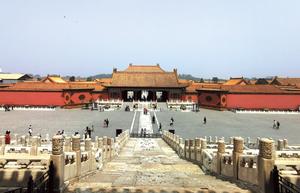 An inner section of the Forbidden City seen from the Hall of Preserving Harmony. (WANG KAIHAO / CHINA DAILY)
An inner section of the Forbidden City seen from the Hall of Preserving Harmony. (WANG KAIHAO / CHINA DAILY)
Milestone achievements
It is hard to say how long these leisurely steps will last at the Palace Museum.
Du Haijiang, deputy director of the museum, says that the daily cap will adjust accordingly, and things will gradually go back to normal.
After all, for a place which witnessed 24 emperors over the course of six centuries, 98 days' shutdown is but a transient moment in its long history.
During the past three months, the Palace Museum was "in closure but not at rest", Du says. About 200 people stayed on duty within its red walls every day to ensure security and remain alert for fire, as well as other potential dangers. Academic research at the institution also continued unabated. The difference was, of course, many researchers' homes became their offices.
Du adds that reopening for public visits will also be followed by a resumption of everyday work in some key positions at the institution, like restoration of cultural relics, by one of the biggest teams of its kind in the world.
"For the 600th anniversary, there will be some adjustments of our plans due to the influence of the novel coronavirus over the few past months," he says, adding that "the general schedule and arrangement of key exhibitions will remain."
Oct 10, which marks the 95th anniversary of the Forbidden City becoming a public museum, will be the focal point of the series of events.
According to the original plan, A Night Revel of Han Xizai, a milestone painting in Chinese fine art history, which is believed to have been created in the 10th century, will be on view to the public later this year, as will calligraphy masterpieces by Su Shi, a renowned poet and artist of the Northern Song Dynasty (960-1127). A new gallery displaying porcelain items will be reopened to the public after renovation and a redesign of its exhibits.
For Zhuang and many other acolytes of the museum, the birthday will be a monumental occasion that cannot be missed.
Contact the writer at wangkaihao@chinadaily.com.cn



